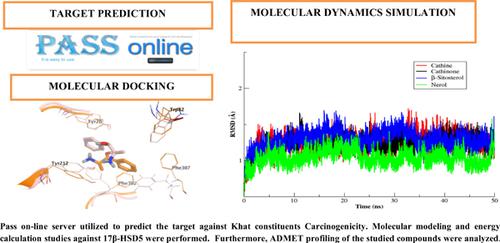Medicinal Chemistry ( IF 2.3 ) Pub Date : 2021-05-01 , DOI: 10.2174/1573406416666201005142522 Maria Saeed 1 , Sajda Ashraf 1 , Rashad Alsanosi 2 , Hassan A Alhazmi 3 , Mohammed AlBratty 3 , Asim Najmi 3 , Asaad Khalid 2 , Zaheer Ul-Haq 1

|
Background: The tradition of khat chewing has been deep-rooted in the African and Arabian Peninsula for centuries. Due to its amphetamine-like psycho-stimulant or euphoric effect, khat has been used by millions in Somalia, Ethiopia, Saudi Arabia and Yemen. The long-term use of khat can induce many major health outcomes, which may be serious and irreversible.
Objective: Prolonged use of khat constituents has been associated with different types of cancers such as prostatic, breast and ovarian cancer. However, it has been very difficult to identify the molecular targets involved in khat carcinogenesis that interact with the Khat constituents by in vitro/in vivo experimental tools.
Methods: In silico tools were used to predict potential targets involved in the carcinogenesis of khat. Pass on-line prediction server was used for the prediction of a potential molecular target for khat constituents. Molecular Dynamics simulation and MM-GBSA calculation of the predicted target were carried out.
Results: Molecular Dynamics simulation and MM-GBSA calculation revealed that among khat constituents, β-sitosterol showed a high binding affinity towards 17β-HSD5. On the other hand, this study highlights for the first time some new interactions, which were observed in the case of cathine, cathinone and nerol during the simulation.
Conclusion: In silico molecular dynamic simulation tools were used for the first time to investigate the molecular mechanism of widely used leaves of psychoactive khat (Catha edulis) constituent. The present study provides deep insight to understand the effect of khat constituents involved in the impairment of the reproductive system and its binding to 17β-HSD5. ADMET profiling also suggested that few khat constituents do not fulfill the requirements of the Lipinski rule of five i.e. poor absorption and blood-brain barrier impermeability.
中文翻译:

通过分子建模方法探索 17β-HSD5 诱导的金缕梅致癌性的分子机制
背景:几个世纪以来,咀嚼阿拉伯茶的传统在非洲和阿拉伯半岛根深蒂固。由于其类似安非他明的精神兴奋剂或欣快作用,卡塔叶已被索马里、埃塞俄比亚、沙特阿拉伯和也门的数百万人使用。长期使用卡塔叶会导致许多重大的健康后果,这些后果可能是严重且不可逆转的。
目的:长期使用卡塔叶成分与不同类型的癌症有关,例如前列腺癌、乳腺癌和卵巢癌。然而,通过体外/体内实验工具识别与卡塔叶成分相互作用的卡塔叶致癌作用中涉及的分子靶标非常困难。
方法:使用计算机工具来预测参与卡塔叶致癌作用的潜在目标。通过在线预测服务器用于预测阿拉伯茶成分的潜在分子目标。对预测目标进行了分子动力学模拟和MM-GBSA计算。
结果:分子动力学模拟和 MM-GBSA 计算表明,在 khat 成分中,β-谷甾醇对 17β-HSD5 显示出高结合亲和力。另一方面,这项研究首次强调了一些新的相互作用,这些相互作用是在模拟过程中在卡辛、卡西酮和橙花醇的情况下观察到的。
结论:首次使用计算机分子动力学模拟工具研究了广泛使用的精神活性卡塔叶(Catha edulis)成分的分子机制。本研究为理解参与生殖系统损伤及其与 17β-HSD5 结合的 khat 成分的影响提供了深刻的见解。ADMET 分析还表明,很少有 khat 成分不满足 Lipinski 5 法则的要求,即吸收差和血脑屏障不渗透性。



























 京公网安备 11010802027423号
京公网安备 11010802027423号